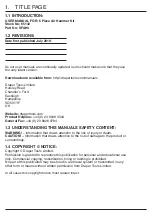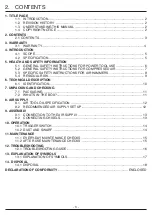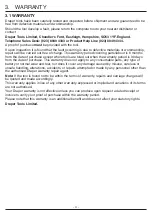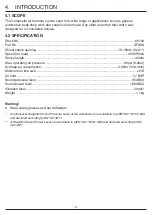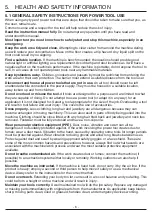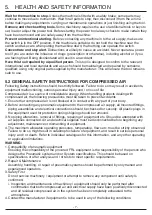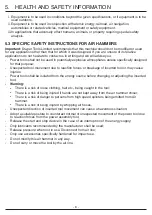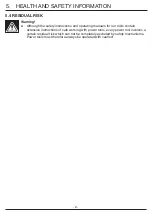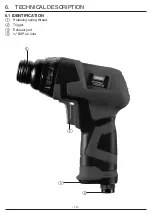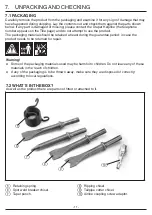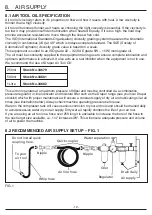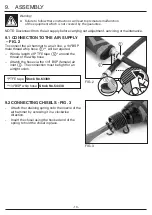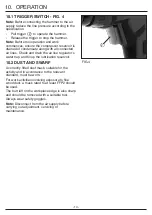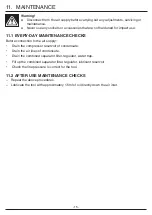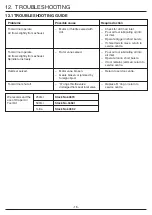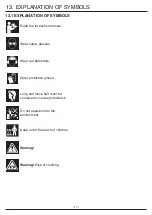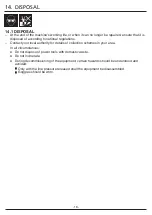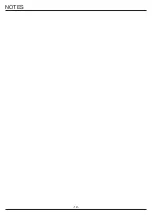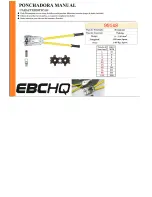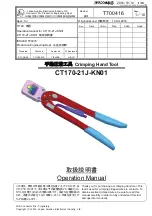
5. HEALTH AND SAFETY INFORMATION
Wait for the machine to stop.
Unless the machine is fitted with a safety brake; some parts may
continue to move due to momentum. Wait for all parts to stop; then disconnect it from the air line
before making any adjustments, carrying out maintenance operations or just finishing using the tool.
Remove and check setting tools.
Some machinery requires the use of additional tools or keys to
set, load or adjust the power tool. Before starting the power tool always check to make certain they
have been removed and are safely away from the machine.
Prevent unintentional starting.
Before connecting any machine in to the air supply, make sure
the switch is in the OFF position. If the machine is portable; do not hold the machine near the
switch and take care when putting the machine down; that nothing can operate the switch.
Concentrate and stay alert.
Distractions are likely to cause an accident. Never operate a power
tool if you are under the influence of drugs (prescription or otherwise), including alcohol or if you
are feeling tired. Being disorientated will result in an accident.
Have this tool repaired by a qualified person.
This tool is designed to confirm to the relevant
international and local standards and as such should be maintained and repaired by someone
qualified; using only original parts supplied by the manufacturer: This will ensure the tool remains
safe to use.
5.2 GENERAL SAFETY INSTRUCTIONS FOR COMPRESSED AIR
Following Safety instructions should be strictly followed. Failure to do so may result in accidents,
equipment malfunctioning, serious personal Injury and / or loss of life.
Compressed air is a source of considerable energy. When handling products dealing with
compressed air, the following precautions must be taken to prevent accidents.
1. Ensure that compressed air is not blocked or in contact with any part of your body.
2. Before connecting any pneumatic equipment to the compressed air supply, all mounted fittings,
piping assemblies and electrical connections should be checked for security. All plastic plugs in
the equipment used for protection during shipping should be removed.
3. No piping alterations, removal of fittings, repairing of equipment etc. Should be attempted with
air supplies connected. Air and electrical supplies must be disconnected before beginning any
adjustment, maintenance or dismantling of equipment.
4. The maximum allowable operating pressures, temperature, flows etc. must be strictly observed.
Failure to do so might result in catastrophic failure of equipment, and result in serious personal
injury and / or death. Refer to individual catalogues for this information, and any other operating
or application limitations.
WARNING:
1. Compatibility of pneumatic equipment
Ensuring the compatibility of the procured FRL equipment is the responsibility of the person who
designs the Pneumatic system and/ or System specifications. This should be based on
specifications or after analysis and / or tests to meet specific requirements.
2. Repair & Maintenance
Assembly, handling, or repair of pneumatic systems should be performed by only trained and
experienced operators.
3. Safety First
Do not service machinery / equipment or attempt to remove any component until safety Is
confirmed.
i. Inspection and maintenance of machinery / equipment should only be performed after
confirmation that both compressed air and electrical supply have been positively disconnected
and all residual compressed air in the system has been completely exhausted to the
atmosphere.
4. Contact the manufacturer if equipment is to be used in any of the following conditions:
10. OPERATION
(2)
FIG.4
10.1 TRIGGER SWITCH - FIG. 4
Note: Before connecting the hammer to the air
supply reduce the line pressure according to the
specification.
- Pull trigger
(2)
to operate the hammer.
- Release the trigger to stop the hammer.
Note: Before tool operation and work
commences, ensure the compressor reservoir is
drained of condensate along with all connected
air lines. Check and drain the air line regulator’s
water trap and fill up the lubrication reservoir.
10.2 DUST AND SWARF
A correctly fitted dust mask, suitable for the
activity and in accordance to the relevant
standard, must be worn.
For work activities involving exposure to fine
wood dust, a mask rated to at least FFP2 should
be used.
The burr left on the workpiece edge is also sharp
and should be removed with a suitable tool.
Always wear safety goggles.
Note: Disconnect from the air supply before
carrying out adjustment, servicing or
maintenance.
- 7 -
- 14 -
Summary of Contents for STORMFORCE 65142
Page 19: ...NOTES 19 ...


